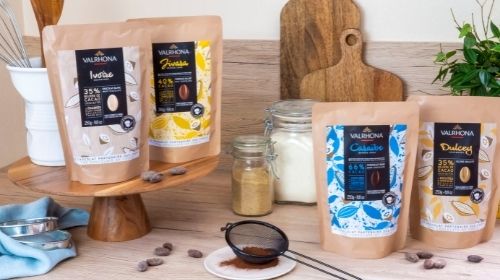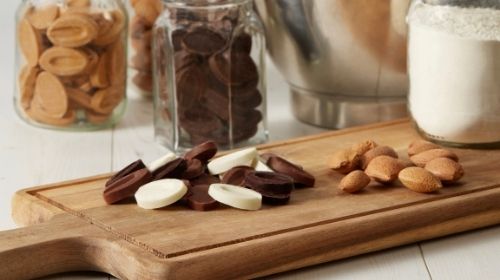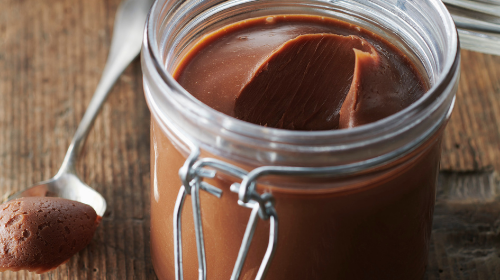How to store chocolate
As any pastry and chocolate maker will tell you: working with quality ingredients is essential to ensure your culinary preparations are a success! This is all the more true for handmade chocolate: a noble ingredient that must be handled with care to preserve its organoleptic properties. To find out how to store your chocolate, you should distinguish between chocolate in its raw form (chocolate bars, couverture chocolate, etc.) and chocolate preparations (cakes, sweets, ganache, pastries, mendiants, mousse, etc.). In any case, good storage of the chocolate will involve controlling the temperature, humidity and brightness.

How to store chocolate bars or couverture chocolates
Cold, heat, humidity and light are the main enemies of chocolate, whether it’s dark chocolate, milk chocolate or white chocolate. You must therefore always keep these conditions in mind to properly store your chocolate, whether it is in the form of tablets, chips or beans. This also applies to chocolates for special occasions (Easter and Christmas chocolates), with the exception of filled chocolates.
Shelf life of chocolate
First of all, we need to answer a crucial question: does chocolate expire? So-called “plain” chocolates and couverture chocolates have a rather long shelf life. Couvertures Valrhona displays a best before date of 14 months.
If you discover some forgotten dark chocolate in your cupboard and the best before date has passed, do not discard it: it remains edible for several months (even up to two years) after this date! If the chocolate has some white traces, don’t panic: the taste and texture may be different but there is no health risk of consuming “expired” dark chocolate and even less of using it for baking!
However, you should be more careful with milk chocolate and white chocolate. As they contain less cocoa, they do not keep for as long. Also be careful with festive chocolates and filled confectionaries (such as chocolate truffles). These should be consumed more quickly (ideally within a fortnight) as they contain water, milk or cream that makes them perishable. Alcohol-filled chocolates can be kept for longer.
Once opened, Valrhona couverture chocolates can be stored in their original, hermetically sealed packaging. Otherwise, you can use an iron box (hermetically sealed and odorless), or even an Insulated bag. This last solution is particularly useful if you need to transport your chocolate.

Can you keep your chocolate in the fridge?
Out of habit, some people store their chocolate in the refrigerator. This solution may seem all the more essential in summer, during periods of extreme heat, in order to prevent chocolate from melting. In reality, it is best not to put your chocolates in the fridge: the ideal storage temperature for chocolate is between 57 and 64°F (14°C and 18°C). However, the temperature of a fridge is between 32 and 45°F (0°C and 7°C).
Why does chocolate bleach in the fridge?
If you’ve ever put a chocolate bar in the fridge, you’ve probably seen a white film form on its surface. This is called chocolate bleaching: humidity and cold will affect the sugar in chocolate, which will whiten. This whitening is harmless to your health, but will alter the taste qualities and aromas of chocolate.
Storing your chocolate in a wine cellar: the ideal solution
If you want to make sure your chocolate is neither too hot nor too cold, the best solution is to place it in a wine cellar. This allows you to benefit both from the ideal temperature for storing chocolate, but also from good humidity conditions.
It is recommended to store the chocolate in a cool, dry place (50 to 55% humidity). Remember to pack your chocolate well before storing it, as some wine cellars may be slightly more humid than this. This solution also protects chocolate from direct sunlight.
How to store chocolate preparations?
Once used in your pastries, chocolate will no longer keep in the same way. You will need to take into account the other ingredients that make up your preparation, including milk, butter, cream and eggs.
Chocolate desserts to keep in the fridge
Unlike pure chocolate, some chocolate desserts are best kept in the fridge. This is mainly the case for all preparations containing sensitive ingredients, in order to avoid any microbial problems.
Chocolate desserts that can be stored in the refrigerator include:
- Truffles
- Mousses
- Ganache
- Éclairs
- Puddings
- Fondants
Remember to take your pastries out of the refrigerator about 15 minutes before tasting them. This will allow them to return to their normal temperature and regain their texture and aromas.
Chocolate preparations to store at room temperature
For less sensitive preparations intended to be eaten shortly after creation, it is perfectly possible to store them at room temperature (approximately 70°F or 20°C). However, you will need to ensure that they are properly packaged (hermetically sealed box, cling film, etc.).
Mendiants, pains au chocolat, donuts and most chocolate cakes (molten chocolate cakes, brownies, muffins, etc.) can thus be kept at room temperature if they are properly packaged. Chocolate cakes can also be stored in the fridge.

Can you freeze chocolate desserts?
If you want to store your chocolate preparations for longer, you can put them in the freezer without issue. The fat contained in desserts makes it possible to freeze them properly.
Again, be sure to protect them with a freezer bag or cling film. You can store your chocolate desserts this way for several months. Note, however, that the more you keep them in the freezer, the more your desserts will tend to dry out.
When you want to eat them, just take them out of the freezer and leave them at room temperature. Putting them briefly into the oven may also be considered. However, avoid using microwaves, which tend to soften pastries.
Storing chocolate: special cases
Some chocolate-based preparations have special storage conditions. This is the case with tempered chocolate, which simply cannot be stored. After tempering, the chocolate must be used immediately for molding, decoration or coating.
Another special case: hot chocolate
If you want to transport it to drink it later, you can definitely use an insulated mug or bottle to keep it hot. However, do not wait more than a few hours, as the milk may ferment.
You now know the best conditions for preserving all the aromatic properties of your chocolate. Feel free to share these tips with friends and family!
 Microsoft Edge
Microsoft Edge
 Google Chrome
Google Chrome
 Mozilla Firefox
Mozilla Firefox
 Opéra
Opéra


